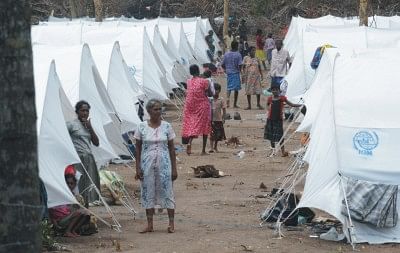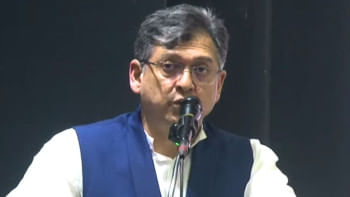Defeated Tigers confirm Prabhakaran's death

Internally displaced Sri Lankan people walk in the space between tents at Menik Farm refugee camp in Cheddikulam. Photo: AFP
The defeated Tamil Tiger rebels confirmed Sunday that their supreme leader was killed in the group's final battle against Sri Lankan troops.
The almost mythic commander, Velupillai Prabhakaran, led a terror-driven Tamil insurrection in Sri Lanka for more than a quarter century. Last week the government declared it finally killed Prabhakaran and proclaimed victory against his Tamil Tigers, crushing the rebellion that the UN estimates cost between 80,000 to 100,000 lives.
But many Tamils didn't believe it.
For some die-hard followers, especially those living abroad, it hardly matters whether the legendary guerrilla is alive or dead, as long as there is a continuing story line of an independent Tamil state in part of this Sinhalese-dominated island.
Meanwhile, the government said it believes Prabhakaran's deputy and feared intelligence chief was also among the dead but his body has not been identified.
Sri Lanka's Defence Secretary Gotabhaya Rajapaksa said in an interview with privately owned Derana TV on Sunday that soldiers have still not been able to identify the body of Pottu Amman, who along with Prabhakaran were wanted by India for the assassination of former Prime Minister Rajiv Gandhi.
"There is no doubt that he's been killed," he said
The military earlier claimed to have identified the body of the spy chief. Rajapaksa did not explain the contradiction.
Gandhi was assassinated in 1991 by a female suicide bomber at an election rally.
Prabhakaran, who was 54, was a larger-than-life character who championed the dreams of the Sri Lanka's minority Tamils. He was seldom seen in public, yet his word was unquestioned. He governed by fiat over a de facto state in one-third of this Indian Ocean island.
Even many Tamils who abhorred the Tigers' suicide bombings and assassinations embraced him as their hope for dignity and equal rights in Sri Lanka.
Bloggers compared Prabhakaran to the Hidden Imam, who was born in the 9th century but who Shia Muslims believe never died. Believers say the Hidden Imam will return one day to bring peace and justice to the world.
The Sri Lankan army says Prabhakaran was among the last to die in the civil war's final battle on Tuesday. His body was found in a thicket of mangroves along a shallow lagoon on the desolate northeastern coast.
Photographs of the familiar moustachioed face, a handkerchief covering the fatal head wound, were splashed on the front pages of Sri Lanka's national papers on Wednesday. Unpublished pictures show a sickle-shaped gash through the bone of his forehead. His dog tags number 001 and ID card were put on display for the cameras.
Selvarasa Pathmanathan, the rebels' international spokesman, confirmed in a statement Sunday that Prabhakaran "attained martyrdom fighting the military oppression of the Sri Lankan government." He died on May 17 in a bloody battle on the island's northeast coast.
Pathmanathan said the group had declared a week of mourning starting Monday for Prabhakaran and urged the Tamil people to "restrain from harmful acts to themselves or anyone else in this hour of extreme grief."
Army commander Gen. Sarath Fonseka said in an interview published Sunday that Prabhakaran's remains were quickly cremated. "His body was burnt in that area and the ashes were sent to the sea," he told the Sinhalese-language Rivira newspaper.
Before Sunday's announcement by the Tigers, many questioned the veracity of the military's claims about his death.
Kanagalingam Sivajilingam, an ethnic Tamil lawmaker, said the government's behaviour was suspicious, and he doubted the corpse shown in the photographs and in television footage was indeed that of the founder and leader of the Liberation Tigers of Tamil Eelam.
"I can't prove if he is among the living or dead ... But I have my doubts about this body," he told The Associated Press.
Why, he wondered, were independent journalists not allowed to see the body before it was burned and the ashes scattered. "Only a DNA test will be an effective proof," he said.
Feeding the disbelief were the previous erroneous reports of Prabhakaran's end. He was thought to have been killed in fighting in 1987 by Indian troops summoned to help stop the civil war. He was believed to have drowned in the 2004 tsunami, along with some 35,000 Sri Lankans. Then he was reported to have been hit during bombing last year.
News of Prabhakaran's death this time brought thousands of cheering people onto the streets of Colombo, and set off a frenzy of self-congratulatory festivities by the government.
But Tamil neighbourhoods were silent. Several world capitals with large Tamil expatriate communities witnessed demonstrations of protest.
"Looking at the incidents, the reports appear false to me. It is very much possible that he is alive. I am saying this because he has escaped the jaws of death many times and because of his fighting spirit," said Baskaran Vinasithami, who lives in Switzerland.
On Friday, the TamilNet Web site, the main LTTE information outlet, said reports of Prabhakaran's death were "engineered rumours" spread by the government.
"Our beloved leader is alive," it quoted a man identified only as Arivazhakan, head of the Tigers' International Secretariat of Intelligence.
In the interview, Fonseka gave more details of the final clash, in which the rebel chief and the last 100 of his men were trapped in an ever-tightening vise after nearly a year in retreat.
Fonseka warned that the spirit of Eelam, or a Tamil national home, may outlive Prabhakaran.
"What we did in this fight was to destroy the front-line killers, but we don't think that all Eelamists are destroyed," the army chief said.
"Everyone must remember that the war is still not over. As an army, as a government and as a people we must realise this. Otherwise all what we did will be a waste."

 For all latest news, follow The Daily Star's Google News channel.
For all latest news, follow The Daily Star's Google News channel. 



Comments